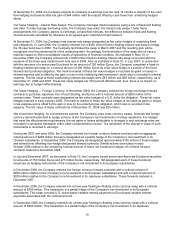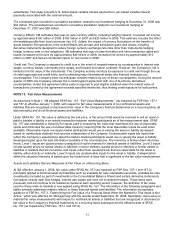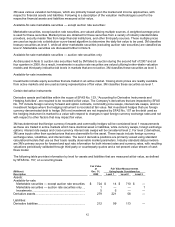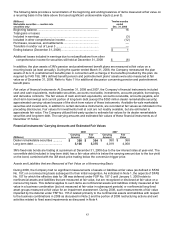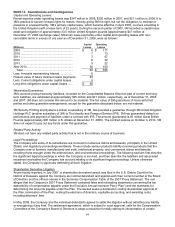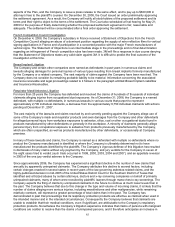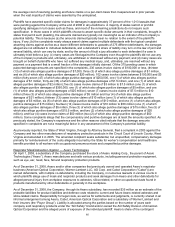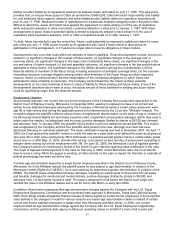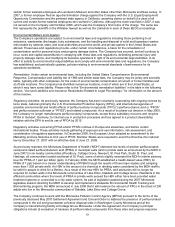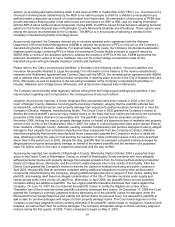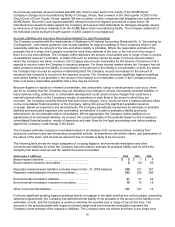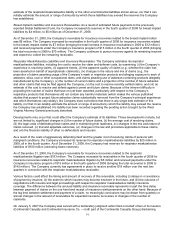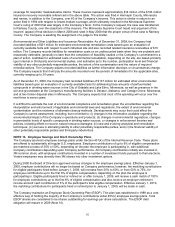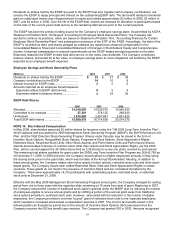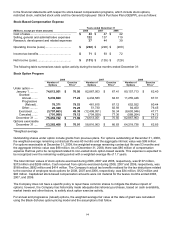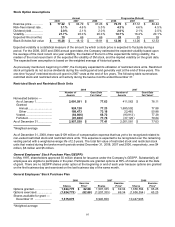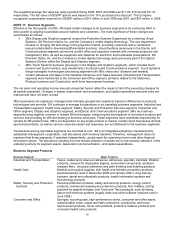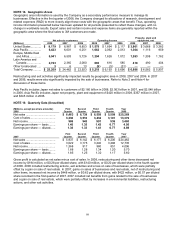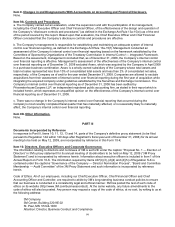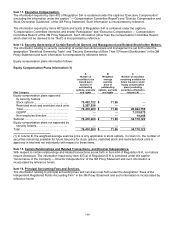3M 2008 Annual Report Download - page 96
Download and view the complete annual report
Please find page 96 of the 2008 3M annual report below. You can navigate through the pages in the report by either clicking on the pages listed below, or by using the keyword search tool below to find specific information within the annual report.
90
As previously reported, several hundred plaintiffs who claim to have lived in the vicinity of the ACME Barrel
Company’s storage drum reconditioning facility in Chicago, Illinois, filed a lawsuit in the third quarter of 2003 in the
Circuit Court of Cook County, Illinois, against 3M and a number of other companies that allegedly were customers of
ACME Barrel. Since the Court rejected plaintiffs’ attempt to have this litigation proceed as a class action, 66
individuals have asserted claims against the Company and several other defendants for damages allegedly caused
by emissions of hazardous materials from the ACME Barrel drum reconditioning facility. The Company settled all of
the individual claims during the fourth quarter of 2008, subject to court approval.
Accrued Liabilities and Insurance Receivables Related to Legal Proceedings
The Company complies with the requirements of Statement of Financial Accounting Standards No. 5, “Accounting for
Contingencies”, and related guidance, and records liabilities for legal proceedings in those instances where it can
reasonably estimate the amount of the loss and where liability is probable. Where the reasonable estimate of the
probable loss is a range, the Company records the most likely estimate of the loss, or the low end of the range if
there is no one best estimate. The Company either discloses the amount of a possible loss or range of loss in excess
of established reserves if estimable, or states that such an estimate cannot be made. For those insured matters
where the Company has taken a reserve, the Company also records receivables for the amount of insurance that it
expects to recover under the Company’s insurance program. For those insured matters where the Company has not
taken a reserve because the liability is not probable or the amount of the liability is not estimable, or both, but where
the Company has incurred an expense in defending itself, the Company records receivables for the amount of
insurance that it expects to recover for the expense incurred. The Company discloses significant legal proceedings
even where liability is not probable or the amount of the liability is not estimable, or both, if the Company believes
there is at least a reasonable possibility that a loss may be incurred.
Because litigation is subject to inherent uncertainties, and unfavorable rulings or developments could occur, there
can be no certainty that the Company may not ultimately incur charges in excess of presently recorded liabilities. A
future adverse ruling, settlement, or unfavorable development could result in future charges that could have a
material adverse effect on the Company’s results of operations or cash flows in the period in which they are
recorded. The Company currently believes that such future charges, if any, would not have a material adverse effect
on the consolidated financial position of the Company, taking into account its significant available insurance
coverage. Based on experience and developments, the Company periodically reexamines its estimates of probable
liabilities and associated expenses and receivables, and whether it is able to estimate a liability previously
determined to be not estimable and/or not probable. Where appropriate, the Company makes additions to or
adjustments of its estimated liabilities. As a result, the current estimates of the potential impact on the Company’s
consolidated financial position, results of operations and cash flows for the legal proceedings and claims pending
against the Company could change in the future.
The Company estimates insurance receivables based on an analysis of its numerous policies, including their
exclusions, pertinent case law interpreting comparable policies, its experience with similar claims, and assessment of
the nature of the claim, and records an amount it has concluded is likely to be recovered.
The following table shows the major categories of on-going litigation, environmental remediation and other
environmental liabilities for which the Company has been able to estimate its probable liability and for which the
Company has taken reserves and the related insurance receivables:
At December 31 (Millions) 2008 2007 2006
Breast implant liabilities.......................................................... $ 5
$ 1 $ 4
Breast implant insurance receivables .................................... 6
64 93
Respirator mask/asbestos liabilities (includes Aearo in Dec. 31, 2008 balance) 140
121 181
Respirator mask/asbestos insurance receivables.................. 193
332 380
Environmental remediation liabilities...................................... 31
37 44
Environmental remediation insurance receivables ................ 15
15 15
Other environmental liabilities ................................................ 137
147 14
For those significant pending legal proceedings that do not appear in the table and that are not the subject of pending
settlement agreements, the Company has determined that liability is not probable or the amount of the liability is not
estimable, or both, and the Company is unable to estimate the possible loss or range of loss at this time. The
amounts in the preceding table with respect to breast implant and environmental remediation represent the
Company’s best estimate of the respective liabilities. The Company does not believe that there is any single best


